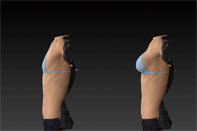Plastic surgeons are usually one of the first to adopt new cutting-edge technologies. This is most often attributed to the importance of the end results of plastic surgery. People get work done because they want to look and feel better.
Advancements in technology have enabled surgeons to give their patients a more realistic expectation of how the final results will look. Virtual Reality (VR) is one of those new technologies that’s taking plastic surgery by storm.
Once relegated to the video game industry, VR has now gone mainstream with many different industries taking advantage of its benefits. We’re going to look at the various technologies such as VR, 3D modeling, and AR, and how they’re being used by surgeons.
What is VR?
Virtual Reality is most often associated with a headset connected to a high-powered computer. When people put on the VR headset, they are instantly taken to another reality. Everything they see on the headset appears in 3D.
Basically, a virtual world is instantly created. For example, someone could put on a VR headset and be immediately transported to a beach in Hawaii. As they turn their heads and look up and down, the images inside the VR headset would move as if they were there in real life.
While Virtual Reality has been around since the 1990s, it was often considered more science fiction than science fact. This is due to the technological limitations of the computers that ran VR in those days.
In the past 10 or so years, computers and the software/hardware that powers virtual reality have become powerful enough to create an image that looks extremely life-like.
Many video game manufacturers have taken advantage of this and released video games which completely immerse people inside their virtual worlds.
Medical science has benefited as well. Plastic surgeons will often give their patients a virtual reality headset that can show them what their new breast implants would look like.
This can be especially helpful in helping the patient decide what size implants to get. Patients can literally “try on” a new set of breasts by simply putting on the VR headset over their head.
Augmented Reality
Augmented Reality (AR) differs from virtual reality in that the headset worn by the person doesn’t cover their eyes completely. It merely augments what someone is seeing.
The “Google Glass” craze a few years ago is a good example of augmented reality. In it, a special pair of eyeglasses were worn, and selected images were shown on the screen which “augmented” what the person was seeing.
It’s been said that AR is much easier to use than VR in this day and age. This is because VR requires much more powerful software and hardware and it’s relatively new.
As time goes by, it stands to reason that VR will undergo a series of technological innovations which will make it the go-to technology for plastic surgeons.
3D Modeling
Before the advent of 3D modeling, a patient would come into a plastic surgeon’s office for a consultation. They would bring with them a bunch of pictures clipped from magazines that show the shape of the nose, breasts, or other body parts they want to have worked on.
The problem with this method is that it was in 2D and didn’t give an accurate picture of what to expect. Surgeons nowadays are using powerful computers and 3D imaging software/printers to give prospective patients a clear understanding of what to expect.
3D modeling works by taking pictures of the patient from different angles. These pictures are then compiled into a special computer program that the surgeon can manipulate at will. It offers a real-life 3D image of what a certain breast size would look like.
If the surgeon has a 3D printer, he can print out a very life-like 3-dimensional image of what the patient’s face, breasts, or other body parts will look like after surgery.
This gives the patient more confidence to undergo the procedure because they will already have a good idea of the outcome.
How Can VR Help Plastic Surgery?
Plastic surgeons are already using Virtual Reality in breast augmentation procedures. When they sit down for a consultation, patients are given a special wearable bra. They then put on the virtual reality headset and can instantly see what their new breasts would look and feel like.
The surgeon sits at a computer and can instantly change the shape and size of the breasts which will be reflected in real time on the headset that the patient is wearing. VR also gives the doctor and patient the ability to see the asymmetries of a proposed procedure and check if it’s possible or not.
Conclusion
Virtual reality augmented reality, and 3D modeling offers patients a way to see the results before they undergo the knife. This can help avoid any “buyer’s remorse” and give the patient a much clearer understanding of what they’re trying to achieve.
As time goes by, advancements in medical technology will get better and better. It stands to reason that one day, a patient will be able to walk into the office of a plastic surgeon and see a 100% life-like image of themselves on a virtual reality headset.















